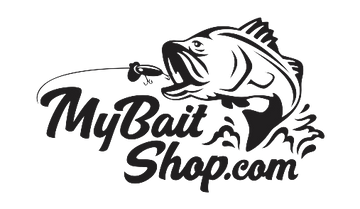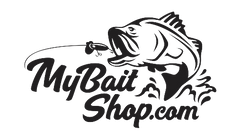History of the South Bend Bass-Oreno
History of the South Bend, Bass Oreno
1915 - 1964
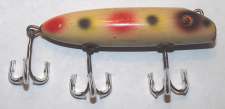
This famous lure appeared in 1915. It underwent many changes through the years but the basic lure design remained the same. Basically this lure is easy to identify by it's eyes. The No-Eye version is a little more complicated and other methods need to be considered such as body style and hook hanger gap. I will discuss this in more detail later on.
The Bass Oreno body did go through some slight modifications throughout the life of this lure. In the beginning this bait measured 3-1/2 inches in length. This early No Eyed Oreno model has been referred to as the Chopped Tail. Peter Bernhart (South Bend expert and long member of the NFLCC) informed me that he now believes that the Chopped Tail was a result of poor Quality Control. Mr. Bernhart thinks that South Bend purchased lure blanks from several lumber mills. Around 1919 South Bend either purchased their own mill or contracted only one mill to produce their blanks. The best way to determine age of these early No Eye Oreno's are by the line tie washers, Tail washers and Hook gap. Washer less are the earliest followed by a very tiny washer that is almost unseen and the latest was the standard type washer.
The 3-3/4 inch length Bass Oreno has been found with three taper tail lengths (Long, Medium & Short). The earliest Oreno's had the Long taper tail length. To determine the taper length, measure with a caliper along the taper to 5/8" diameter. Measure from that point back to the end of the tail. The results of this measurement will indicate the taper length of the lure. See the diagram below to determine the taper length.
| Type of Taper | Measurement |
| Long | 3/4" Taper Length |
| Medium | 5/8" Taper Length |
| Short | 1/2" Taper Length |

NO EYES
-
NO-EYE : Version 1 (c.1915) - This version had a washer-less assembly on the line tie and the tail hook assembly. The body measured 3-1/2" in length. This version had Screw eye hook hangers not the easy off hook hangers. The belly hooks were approximately spaced 1-1/4" apart and the hook hanger cups were unpainted.
-
NO-EYE : Version 2 (1916 - 1917) - This version used a long taper tail length and the belly hook gap was widened to 1-5/16". This version still had the washer-less assembly and the screw eye hook hangers. The body length also remained the same 3-1/2" length.
-
NO-EYE : Version 3 (1918 - 1919) - This version the body length was lengthened to 3-3/4". Washers were added to the line tie and rear hook assembly. They used a long taper tail length and the belly hook gap was widened to 1-3/8" apart. Screw eye hook hangers were still being used at this time.
-
NO-EYE : Version 4 (1919 - 1920) - There were some major changes for this No-Eye version. It still had the long taper tail length. The easy off screw eye hook hangers was first introduced with this version and the hook hanger cups remained unpainted for this period. The belly hook gap was widened again to 1-5/8" apart. The easy off hook hanger (early) were used until they changed to the S-rig hook hardware.
-
NO-EYE : Version 5 (1920 - 1925) - The only change for this final No-Eye version was that the taper length changed to the medium taper tail length. All other features remained the same as version 4.

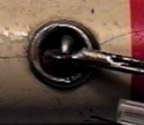
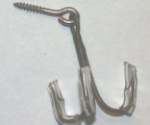
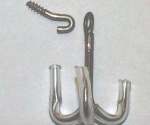

- Screw Eye Hardware (1912 - 1918) - Screw eye hardware the loop was bent closed and the hooks could not be easily changed.
- (early) Easy-Off Hardware (1919 - c.1924) - South Bend changed to easy-off hook hardware in 1919. It look very much like the screw eye that had been bent open. This was done to allow the fisherman to easily change the hooks.
- (later) Easy-Off Hardware (c.1925 - 1950) - In the mid 1920's the easy-off hook hardware now was cut to a sharp point. It now looked more like a fish hook.
| 1 | Frog | 1916-1925 |
| 2 | Solid Red | 1916-1920 |
| 3 | Rainbow | 1916-1925 |
| 4 | Red head, White body | 1916-1925 |
| 5 | Red head, Aluminum body | 1916-1925 |
| 6 | White body with Spots | 1916-1925 |
| 7 | Yellow body with Red & Green Spots | 1916-1925 |
| 8 | Blue head, White body | 1919-1922 |
| 9 | Luminous | 1916-1925 |
| 10 | Red blend, Scale Finish | 1919-1925 |
| 11 | Green Scale | 1919-1925 |
| 12 | Gold body with Red Head | 1919-1925 |
| 13 | Solid Black | 1921-1922 |
| 14 | Red body, Black head | 1921-1925 |
| 15 | Mullet Scale, Blue | 1922 |
| 16 | Yellow Perch Scale | 1922-1925 |
GLASS EYE : Version 6 (c.1926 - 1927) - This was the beginning of the glass eyes. They utilized the same body style as the No Eye, version 5. This version lasted a very short time, possibly for only one year. One theory is that the added weight of the glass eyes affected the lure's action. This version used the (later) easy-off hook hardware.
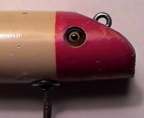
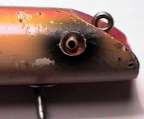
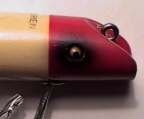

| 1 | Copper | 1926 | |
| 2 | Frog | 1926-1934 | |
| 3 | Gold body, Red head | 1926 | |
| 4 | Luminous | 1926-1934 | |
| 5 | Red body, Black head | 1926-1934 | |
| 6 | Rainbow | 1926-1934 | |
| 7 | Red head, White body | 1926-1934 | |
| 8 | Red head, Aluminum body | 1926-1934 | |
| 9 | Red blend, Scale finish | 1926-1934 | |
| 10 | Green Scale | 1926-1934 | |
| 11 | White body with Spots | 1926-1934 | |
| 12 | Yellow body with Red & Green Spots | 1926-1934 | |
| 13 | Yellow Perch | 1926-1934 | |
| 14 | Pikie scale | 1927-1934 | |
| 15 | Goldfish, Natural scale | 1927-1930 | |
| 16 | Shiner Natural scale | 1928-1930 | |
| 17 | Red Stripes (4) on White body | 1930-1931 | |
| 18 | Pearl | 1930-1934 | |
| 19 | Red head, Silver Speckled body | 1930-1931 | |
| 20 | Black, Red around the Eyes | 1931 | |
| 21 | Black Arrowhead, White body | 1932-1934 | |
| 22 | Red Arrowhead, White body | 1932-1934 | |
| 23 | Red Arrowhead, Yellow body |
|
TACK EYES : Version 10 (c.1935 - 1942) - During this version the eyes were changed to Tack eye. In all other respects it is the same as version 9. They still used a short taper tail length, painted hook hanger cups and "Bass Oreno" stenciled on the back.
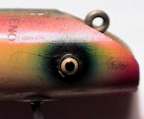



|
Cataloged Colors for Tack Eyes 1935 - 1950 |
|
|
|
CARVED EYE : Version 12 (1951 - 1966) - The Carved eyes also known as Pressed eyes were the next version of the Bass Oreno eye stages. These lures were now equipped with Surface Rig hook hardware. The B.F. Gladding & Co. were a well known maker of casting and fly lines and they purchased the South Bend Tackle Company in 1964. Early (1964 - 1966) Gladding-South Bend Bass-Oreno lures had carved eyes.
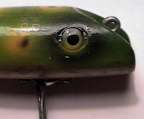

|
Cataloged Colors for Carved Eyes 1951 - 1964 |
|
|
|
PAINTED EYE : Version 13 (c.1967 - 1982) - The carved eyes decreased until finally they changed into painted eyes after 1966. If you find a Bass Oreno with painted eyes it is a Gladding-South Bend lure made after 1966. Gladding-South Bend continued to make the Bass Oreno lure until 1982 when Luhr Jensen company acquired the rights to make and sell the entire Oreno line of lures.

My Bait Shop Updates:
If you have any further information on any of the items displayed on this page which you'd like to share, please send your comments to me and I'll update the page accordingly. Contributions of interesting items and/or unknowns are encouraged.
© 2024, My Bait Shop, LLC
